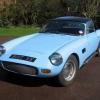Renault blown floor uses 10% more fuel
By Sam // April 6, 2011
Renault R31
Renault Sport F1 has revealed that during the Australian Grand Prix Red Bull and Renault used 10% more fuel than normal. The blown floors prevalent in the field this year mean that engine and exhaust management is even more crucial than in previous seasons. To power a blown floor effectively and generate additional downforce, an engine must produce significant amounts of exhaust gas. Simply put, the more fuel burned, the more exhaust is produced and potentially more downforce. “Since the RS27’s fuel consumption rate is extremely good, the Renault-equipped teams were able to burn 10% more fuel than normal during the Australian Grand Prix without running out of fuel, therefore giving more exhaust flow to its partners using the blown diffuser” a Renault release revealed.
The Ferrari 056 is thought to have the highest fuel consumption in Formula 1.
I think that 10% more fuel consumption is considerable. It is not in the interest of the sport to increase fuel consumption. I expect that something will be done about it in the future.
Edited by WhiteBlue, 06 April 2011 - 14:00.



































